All children deserve a quality education. Together, we can help them reach their dreams.
Learn more about Teach for Life, the educational branch of Trees for Life.

This is the story of my village, Mulbar, in a remote area of Orissa state, India. I was born there in 1935.
Orissa is known as one of the most backward and poverty-ridden states in India.
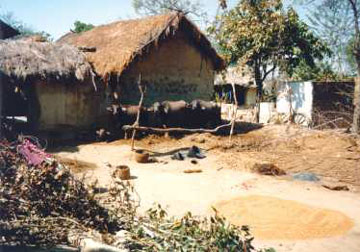
My village represented the very soul of such poverty and backwardness. Since time immemorial, life in Mulbar had stood still, as if in a permanent cocoon.
Then one day a stranger came to our village, and everything started to change. In our village we called him a farishta, an angel.
I have vivid memories of life in our village in the early 1940s, when I was growing up. The total population of my village was 400. The status and profession of a person were determined by the caste into which one was born. This caste system was thousands of years old, and it was iron-clad.
At the top were the Brahmins, the priestly class. They earned their living by performing priestly duties and did not do any manual work. There were six Brahmin families in our village.
Below them were people of intermediate classes. These people included farmers, oil extractors, barbers, water suppliers, blacksmiths, potters, fishermen, and so on. I was born into this intermediate class in a family of farmers.
The lowest class was the native forest-dwellers. They were the original people who had lived in the dense forests there before people from surrounding areas moved in several hundred years ago. They were called "tribals." Yet even below them were the untouchables. The descendents of slaves, untouchables were hardly considered human. They were literally not to be touched. The tribals and the untouchables constituted nearly sixty percent of our village population.
Our village had about 500 acres of farmable land. The British government had deeded 120 acres of this land to the village headman. He belonged to the intermediate class of oil extractors. Similarly, his three head assistants were deeded 10 acres of the land each. These assistants helped maintain communication with the British administration and served as the headman's bodyguards. All of these posts were hereditary. These people did not have to pay taxes on their land, but they also did not receive any other compensation for their work.
The village headman's house was easily recognizable, because it was the only house with clay tile roofing. Everyone else in the village lived in mud huts with straw-thatched roofs. The remaining 350 acres of the land were divided between the rest of the village families. Each of the Brahmin families owned about ten acres. Families of intermediate classes had between two and eight acres. My father had 2½ acres of land. Very few tribal people had any land. The untouchables were not allowed to own any land, with the one exception of the untouchable who served as the village night watchman.
Besides farming his land, my father also served as the village veterinarian. He was a tall, muscular man with a strong physique. He had a knack for treating animals, and all of the villagers called upon him when their cattle needed tending. He never charged anyone for his services. He was a pious man who tirelessly volunteered for almost anything needed in the village.
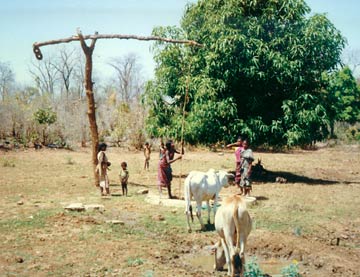
Scarcity: For nine months each year there was hardly any water, even for drinking. The land produced very little food and our cows barely gave any milk.
The climate in our village had always been very harsh. During the four months of summer—April through July—temperatures of 113 to 115 degrees were quite normal. We did usually get some 35 inches of rain per year, but it all came as a downpour between July and October—the monsoon season. As a result, for nine months each year we had practically no water, except for what little we could get from the village pond and a few hand-dug wells. Cultivation could take place only during those rainy months.
People in our village grew only rice and a few vegetables, most of which were sold in the markets in nearby towns. We had no access to high-yielding seeds or chemical fertilizers, and we had no means to create water sources for irrigation. If the rains were good, a farmer could produce between 500 and 600 pounds of rice per acre. That amount of rice was worth fifty to sixty rupees in the open market. I am told that at that time a dollar was worth three rupees. So a farmer could produce between seventeen and twenty dollars worth of rice per acre. That was just barely enough to provide a family's minimum needs for survival.
Rice, our staple, was cooked in earthen pots over a wood fire. Most of us could only afford to eat rice with salt, onion and tamarind—a locally grown sour fruit. Only on very rare occasions did we get some vegetables or lentils, the main source of protein. Our family, like other landowners, also had a couple of cows. The milk production, however, was very low. Only a few cups of milk were available each day when the cows were producing milk, and some of that had to be sold just to feed the cows. Looking back, I realize that all of us suffered from malnourishment.
The main source of cash income was to collect kendo leaves to make native cigarettes, or mahua flowers to make native liquor. This work was possible for only one month in a year. Men were paid 50 paisas (17 cents) a day and women were paid 37 paisas (12 cents) a day. For half of each year all the farmers had no work, so they busied themselves by either hunting rabbits or playing cards. There was nothing else to do. The very few lucky people who were able to save hoarded their money in gold and silver jewelry. There were no banking services.
The landless untouchables and tribals had no option but to work for a pittance for the farmers during the rainy season. Beyond that, they survived by illegally cutting and selling wood from the forest. They possessed nothing but a few pieces of clothing, a woven hemp cot to sleep on, and one or two axes for cutting trees. Lacking all hope of escape from their life of misery, their only relief was found in country-brewed liquor. This addiction had a ruinous effect on these half-starved people's health and economy.
A native herbal medicine practitioner was the ultimate authority on health problems. He was also the only person in the village who possessed a bicycle, an object of great wonder for all of us. The nearest hospital was seventeen miles away, and until 1947 there was not one single case of a patient being taken for treatment to the hospital. One was lucky to survive childbirth or cholera, smallpox, malaria, tuberculosis and many other diseases that frequented our village. Denied any medical help, we could only rely on fate.
The village had a school that provided education through the third grade. It had two rooms made of clay, a dirt floor and a tin roof. I was among the 25 to 30 boys who attended the school. We were the fortunate ones because all the other children had to work in the fields. My two younger brothers also got to attend this school after me. We had no sister, but if we had she would not have received any education. At that time girls were confined to household chores only and did not go to school.
My mother came from the nearby village of Badmal. As was the custom in those days, she was married at the age of fifteen. My father was seventeen. My mother became the eleventh member of a joint family that included my great-grandmother, grandparents, great uncle, great aunt, and five uncles and aunts. Like all other women in the village, my mother was illiterate and had to do household chores all day long. This work included fetching water from the pond, taking care of the cattle, cooking and cleaning.
Among adults in the village, there were twenty men who could sign their names in the script of our language, Oriya. Even though my father had only a third grade education, he was one of the ten men in the village who could read the Holy Scriptures. This ability was considered a major scholastic achievement.
During the summer months, the village priest's handsome young son recited stories from the great epics Ramayana and Mahabharata. For us, the characters of these stories were not fictional or mythological. They were real. Singing in lofty tones, the young priest would keep his audience enchanted until late in the night, and indeed for us the characters would come alive.
The lives and adventures of the characters in these holy books had a deep impact on our lifestyle. Their love, devotion, sacrifices, and ethical standards guided us in discriminating between good and evil, and constantly inspired us toward the finer qualities of life. As a result, community life was generally peaceful and people genuinely cooperated and helped each other.
The headman was the de facto government and ruled with an iron fist. He collected taxes on behalf of the British government and provided the officials with local intelligence on deaths, births, thefts, illicit liquor distilling, movements of criminals and any fights in the village. Ten young men from landless families worked on the headman's farm as bonded laborers. Two untouchables had to tend his cattle. These people were given food and a mere pittance of cash. Besides that, each year everyone in the village had to contribute two days of free labor on the headman's farm.
The headman presided over a court of five people who administered justice, settled disputes and ordered punishment. The other four members of the court were his cronies and dared not oppose him on any issue. The judgments were not fair or equitable but represented the whims and interests of the rulers. Words cannot describe the tyranny of their rule, especially over the untouchables and native tribes.
Escape from the village
I remember 1947 very well. It was the year when India finally threw off the yoke of British rule. That was also the year when I graduated from the third grade at our village school, and my parents decided to send me to a school in a nearby village for further studies. I was twelve years old.
My further education became the subject of heated debate between my father and his brother. His brother correctly anticipated that my father's intentions of providing further education to his children would cause a major financial burden on the joint family. In the end, the joint property was partitioned. My parents' share included 2? acres of land, one 8' x 8' room in the family house, one young bull and some household cooking utensils.
During the next three years my teachers prepared me to successfully pass the seventh grade exam. This qualified me to go to high school in a nearby town. However, we did not have enough money for the school. Luckily, I was able to get one of only two scholarships available in the entire county. This scholarship covered my room and board. In exchange, I did the shopping for the dormitory. For other expenses, my father had to provide five rupees ($1.75) each month. To obtain this money he had to cut wood from the forest and sell it in the town where I was studying. During that time he also had to work as the night watchman for the headman's cousin. He did this work to cover a small sum of money he had borrowed at 25% compound interest and had been unable to repay.
After graduating from high school in 1953, I could not find a job. Meanwhile, my brother Rushi, who was four years my junior, had passed the seventh grade. Lack of funds prevented his further education, and he had to go to work in Sambalpur, the big town in our area. Rushi had an entrepreneurial streak in him, and a few years later he started his own business: a small pharmacy in Sambalpur. In 1955 I was lucky enough to get a job as a post office clerk in Sambalpur.
By that time our third brother, Saheb, had also passed the seventh grade. Saheb joined Rushi and me in Sambalpur for further education. From there he was able to get into medical college. With our meager family resources, Saheb had to struggle hard to maintain himself in school. After graduation from medical college, Saheb was able to immigrate to the United States. By then Rushi's pharmacy had grown, and I joined him as a partner in the business.
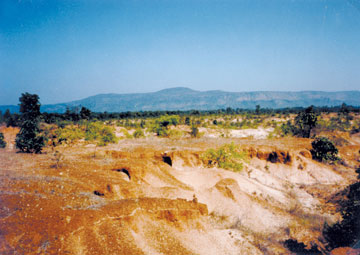
Denuded land: surrounded the village as the population grew and needs increased for land and fodder.
As a result of tremendous sacrifice on the part of our parents, we had escaped from the strangling poverty of the village.
Our village after Independence
It was not until 1988 that the stranger appeared in our village. During the 41 years since Independence, our village had undergone perceptible changes.
The population of the village had now grown to 1200 people. Additional acreage was brought under cultivation. New and better seeds and fertilizer had been introduced to increase agricultural productivity. Four deep wells had been dug to provide drinking water. There were now two brick homes, and several houses had clay tile roofs rather than thatched roofs. Now there were twenty bicycles and even two motorbikes in the village. The school had been upgraded from third grade to seventh grade. A few girls could now be seen going to schools. The literacy rate grew to almost twenty percent, and twelve people now held low-rank jobs with the government.
Now there was even a hospital only seven miles away. Occasionally a lady health worker visited the village to guide people on health problems. In 1985 electricity had arrived in our village, and sixteen households got electrical connections. The autocratic and unjust rule of the village headman was gone, and there was an elected assembly of five people that managed the village.
Although our village had seen much progress, only a dirt road connected it to the rest of the world. One had to cross two shallow rivers by bullock cart or jeep during the dry season. During the rainy season, vehicles could not cross the river.
With the increase in population and needs for additional land and fodder, the hills and surrounding land had been completely denuded of trees. Gone with them was the rich wildlife. The water table went down from fifteen feet to almost fifty feet. Former rivers and ponds were now dry, and there was a tremendous scarcity of irrigation water. The increased agricultural production fell far short of meeting the needs of ever-hungry mouths. Unemployment grew. The villagers divided into opposing splinter groups. A general feeling of helplessness overtook the feelings of family and unity in our village. Abuse of liquor became common to all classes. Petty disputes and litigation became rampant. Everyone expected the government to solve all their problems, but that did not happen. People became cynical about any attempt to improve their community.
It was in this atmosphere that the stranger appeared in our village.
It was a grueling summer afternoon in May 1988 when a jeep drove into Mulbar village. Two men dismounted at the edge of the village and walked to the village square. Soon some village men started to drift in to meet the strangers. They saw a man dressed in white Indian clothes, and another, much younger in age, dressed in western clothes. Both were covered with dust from head to toe.

Turning point: On May 4, 1988, villagers gather around the dust-covered stranger, pledging to implement the Trees for Life formula in our village.
The man dressed in white Indian clothes said his name was Balbir Mathur. Years ago he had immigrated to the United States, where he now lived with his family. He was part of a movement called Trees for Life that was helping people in villages like ours to plant fruit trees. My younger brother who lived in the United States was a friend of his, and had told him about our village. He had come to meet with the people. He and his young friend had traveled that day from Bhubaneswar, which was 240 miles away. That explained why they were covered with dust.
Mr. Mathur told the villagers that his great-grandparents had come from a village similar to ours. He had heard stories from his grandmother about how poor their family was. However, his grandfather and his father were able to climb out of poverty. As a result, he was able to go to America. There he had spent the last thirty years discovering the formula for what makes people powerful and prosperous and what makes people powerless and poor.
He knew that many people must have helped his grandfather break out of poverty. He was now repaying the debt incurred by his ancestors by sharing the formula with anyone who wanted to know. That was what brought him to our village.
The assembled villagers asked Mr. Mathur to share that formula with them. He told them that self-confidence and self-help were the keys. They must not depend upon the government or anyone else to come and help them. He advised them to start the process of self-help by planting fruit trees.
The people who gathered around him that day in the village marveled at his sincerity of purpose. They could hardly believe that he had come all the way from America to their village to share this message with them. The informal way he talked and behaved with them, the lack of grandeur of his visit, and above all his humane approach gained their confidence. In that very first meeting, they agreed to follow his plan. A committee of seven volunteers was formed to determine how many fruit trees the villagers required. Mr. Mathur assured them that their requirement would be supplied free of cost to them.
On his way back from the village, Mr. Mathur came and met me in Sambalpur where my brother and I ran the pharmacy. He entrusted me with the task of working with the village committee and acquiring the saplings for them. Being a native of that village, I took the task as a divine blessing.
From that day onward our village had a holy association with Trees for Life. In our language we call such a holy association Sat Shang.
The work starts
Within a few weeks Mr. Mathur was back in Sambalpur again. This time I arranged for several of my friends to meet with him. Like the villagers, they also took a great liking to him, and a core group of Trees for Life volunteers was formed in my living room. It included a businessman, a banker, an ecologist, a college professor and myself.
Our team procured 2,000 saplings of the finest quality mango, coconut, jackfruit, guava, papaya and lemon trees. We worked with the village committee to provide training on how to plant and care for the saplings to assure survival. A religious ceremony was held to seek God's blessings on this new initiative. The villagers planted these holy trees with great enthusiasm.
After the planting of the trees, a nursery was established in Mulbar to supply saplings to other villages. In the following year, the work spread to two other villages. By the third year the fruit tree planting work had spread to some 300 villages. Along with the tree planting, many other projects were begun.
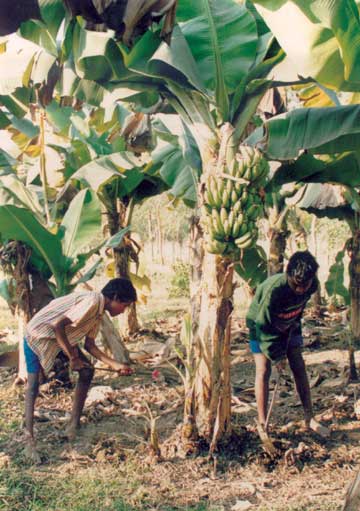
Trees for Life volunteers came to our village from other parts of India, the United States, the UK, and European countries. These volunteers were experts in various fields, such as agriculture, horticulture, soil conservation, irrigation, organic manure, rural development, education, community service, forestry, herbal medicines, photography and tailoring.
Through interacting with these visitors, people in our village overcame their inferiority complex and gained self-confidence. They learned of the urgent needs to protect our environment, adopt modern agricultural practices, educate girls, and conserve soil. They also learned about family planning, vitamin deficiencies and health and sanitation in general.
Trees such as lime, papaya, guava and moringa were planted in family backyards to meet vitamin and mineral deficiencies. Efficient cooking stoves were installed in many homes to save wood and prevent women from inhaling smoke while cooking over open fires.
Water comes to our village
During one of Mr. Mathur's interactions with the villagers, a delegation of women pointed out the urgent need for water for irrigation. Trees for Life volunteers went into action.
Government agencies had certified that there was no more ground water in the region. A retired professor of geology from the adjoining state was invited to make an independent survey. He brought a team of experts who identified eight possible well-digging sites in our village. The villagers contributed towards the cost of conducting this survey.
Still, digging a well was a major risk. What if the water was not found? The debt incurred by a failed digging attempt could literally ruin a villager.
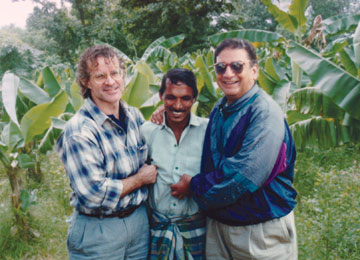
Harihar Sahu (center) was the first farmer to implement the formula. Today he is a wealthy farmer and a businessman, providing jobs for several other people.
Harihar Sahu, a farmer, took that risk. He borrowed money from the bank and drilled a well on his property. Water gushed profusely, and the villagers cheered. It was a huge blow to the myth that there was no underground water in that entire area.
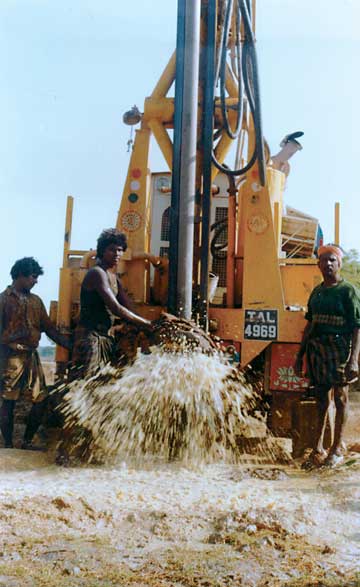
Trees for Life made arrangements for Harihar to receive fifteen days of training at the Government Agricultural Center in another town. There he learned improved agricultural practices. Trees for Life supplied him with an improved variety of banana and other fruit tree saplings to start a plantation. Within one year, Harihar was able to pay off the $1,500 that he had borrowed for his water well.
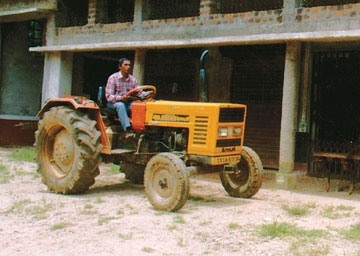
Riding high: Harihar Sahu's tractor symbolizes the prosperity in Mulbar village.
Not only that, but he had also earned enough money to buy the land adjoining his farm. This success of Harihar sparked the imagination of all the villagers. They now became confident that they could also improve their lot.
The current situation in Mulbar
As of the end of the year 2000, there are 25 wells irrigating our fields. People are now harvesting two crops of rice per year, plus sugarcane, bananas, oil seeds and vegetables. In places that were dry, barren land only a few years ago, large stretches of sugarcane and rice fields appear. The planting of fruit and forest trees has become a credo with the villagers. Lemon, mango, jackfruit, moringa and other trees provide nourishment and income for the farmers. Now every able-bodied person can work year-round.

The work culture of the entire population has changed. Farm labor is actually scarce during the harvesting seasons. Farm hands are paid more than the wage fixed by the government. The living conditions of everyone in the village have improved. There are now two tractors, one jeep, 32 motorcycles and uncounted bicycles in the village.

People now live in better houses, are able to acquire health care and education for their children and to eat and dress well. Seventeen families in the village have telephone connections, and many more are in line to receive one. Harihar Sahu, who pioneered the economic boom, is the most prosperous of them all.
In 1990, two years after Mr. Mathur's arrival, the villagers started to build a high school.
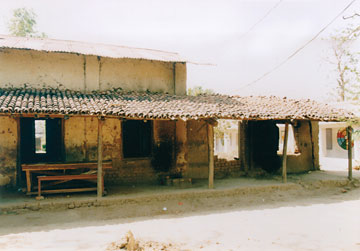
The new school (below) is a great contrast to the old one (above). It provides classes through high school for 200 students. Only a few years ago, there were hardly any girls in schools. Today almost half of the students are girls. School starts with a morning assembly and prayer.
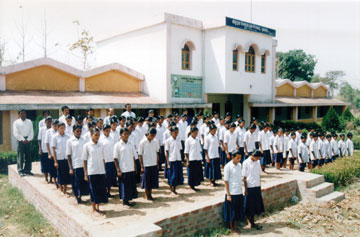
Today the schools in Mulbar provide excellent education to more than 200 students. Children are learning to use computers, and all students learn how to type.
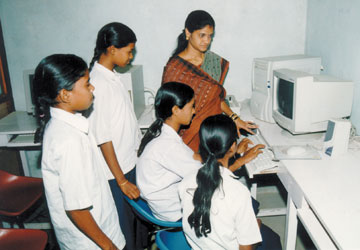
Computer learning is empowering students with knowledge that can help them succeed in today's world.
The high school has more girls than boys. There is even a girls' dormitory so that girls from other villages can attend the school.
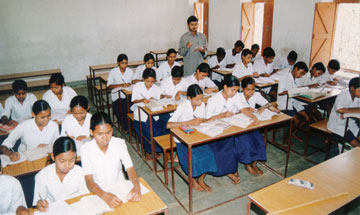
Modern classrooms in the new school enable students to receive a high-quality education.
My brother Saheb and Rotary International helped the villagers start a medical clinic only four miles from the village. Mobile teams consisting of doctors and nurses from this clinic, visit fourteen nearby villages regularly. They visit our village twice a month.

Mobile medical team visits Mulbar regularly to care for the villagers' health.
More important than the material gains, the villagers' attitudes of community living and community service have changed radically. There is not a single case of litigation concerning the villagers in any court of law. Through their own contributions and labor, they have constructed a new primary school building. Regardless of their differences, they have learned to stand solidly behind their spokespersons representing their grievances before government officials. Because of their unity they have convinced the government to construct a paved road to the village, and to build a bridge over the river that used to cut us off from the rest of the world during the rainy season. Now we are connected to the world year-round.
Tens of thousands of forest trees have been planted near our village. The barren lands are rejuvenating. The villagers have decided that in their next community project they will provide drinking water connections to every household.

The village temple
Ultimately, the story of any people is not told in their material development. The real story is in their spiritual progress. In the center of each village and town in our state is a temple, the center of all our activities. Because of religious tradition, these temples are open only to people of the Hindu faith. No foreigner or person of any other faith is ever allowed to enter. Untouchables (who are now called "Scheduled Castes") are not allowed either, even though they belong to the Hindu religion. While women are the most frequent worshipers at the temples, they never have any formal role in conducting religious ceremonies.
In the year 2000, the villagers in Mulbar decided to upgrade their temple. They demolished the centuries-old mud-walled temple to replace it with a temple built of bricks. In February 2001, the foundation-laying ceremony was held. This time was chosen to coincide with Mr. Mathur's visit to the village.
The ceremony started with a declaration that the new temple would be open to all. Twenty-one persons laid the ceremonial foundation stones. Among them were women, foreigners (including non-Hindus), and people of Scheduled Castes. This fact may not seem dramatic, but for these people who had lived in a closed, backward society for centuries, the simple act of women, foreigners and untouchables joining hands to lay foundation stones for the temple was an earth-shaking event.
The people of this remote village were symbolically declaring that they had broken the shell that had calcified over them during the past centuries. A dawn of hope was illuminating the centuries-old darkness of helplessness. It was a declaration of their metamorphosis.
The villagers achieved all this within the brief period of ten years. They did it all through their own efforts. But they do not take the credit for it. They attribute these achievements to their holy association, or Sat Shang, with Trees for Life.
In their first meeting with Mr. Mathur they had shouted in unison, "Ami Korbo!" - "We shall overcome!" They kept the promise they made to a dust-covered angel.
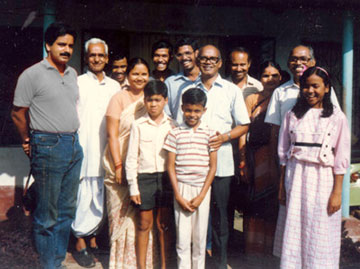
This photo of the Sahu family was taken by Balbir Mathur in Sambalpur, Orissa, on May 5, 1988 -- the day after his first arrival in Mulbar. Among those present were: the young man who drove Mr. Mathur to Mulbar, Singh Deo (far left); Babu Bhai Patel (second from left); my brother, Rushi and his wife, Kankalata (second row, middle); and my wife, Haripriya, and me (second and third from right).
The list of people in Mulbar who helped create the transformation is very long. However, some of the names I do remember are:
Basanta Kumar Dora, Bijaya Kumar Sahu, Debendra Sahu, Ganesh Ram Sahu, Harihar Sahu, Hosiar Singh Meher, Krushna Chandra Sahu, Kumud Chandra Meher, Lalit Sahu, Manoranjan Sahu, Motilal Badhai, Paramanand Hati, Premraj Sahu, Rahasbehari Pradhan, Raija Sahu, Kaviraj Rama Chandra Acharya, Sarat Sahu, Sevaram Ratha, Sukhmuni Suna, Sanjaya Pradhan and Tejraj Sahu.
Then there were the social workers, businessmen, intellectuals, college professors, bankers, doctors, government officers, and people of many other disciplines from cities far and near who provided the necessary knowledge, connections, time, money and caring to make such a transformation possible. These people included: Babu Bhai Patel, Bandita Pradhan, Bhagabata Nanda, Bhagirath Poonia, Bisayak Pradhan, Biswanath Hota, Dashrathi Sahu, Dr. Harishankar Panda, Jadunandan Panda, Fr. John Meliekal, Kunja Behari Sahu, R. K. Kar, Ramgadhar Panda, Rina Dey, Rupeswar Sahu, Saheb and Krishna Sahu, Saroj Mohanty, Sawarmal Gupta and Sushim Amitav Das.
Bijay Kumar Agrawal, a businessman from Sambalpur, deserves a special mention for helping create the platform and providing leadership so that people from all across the state benefit from this self-help movement.